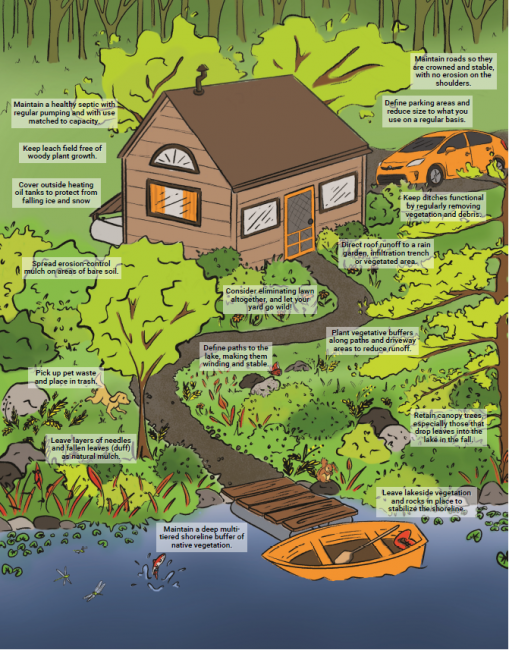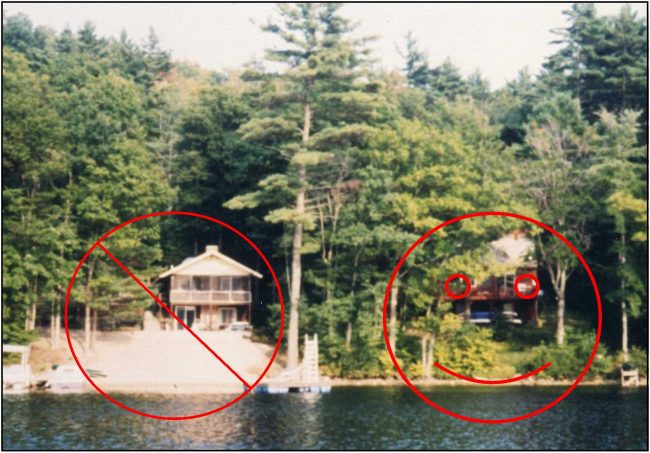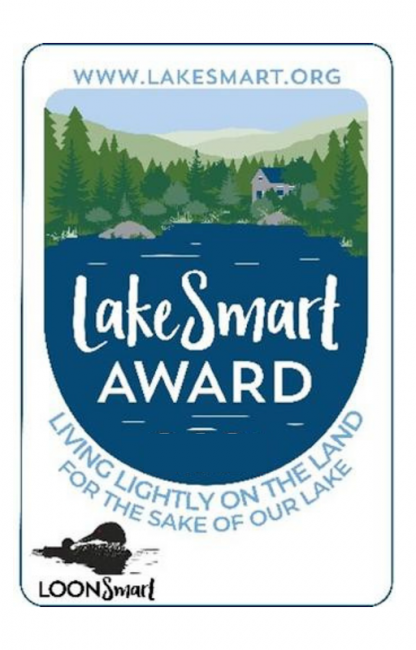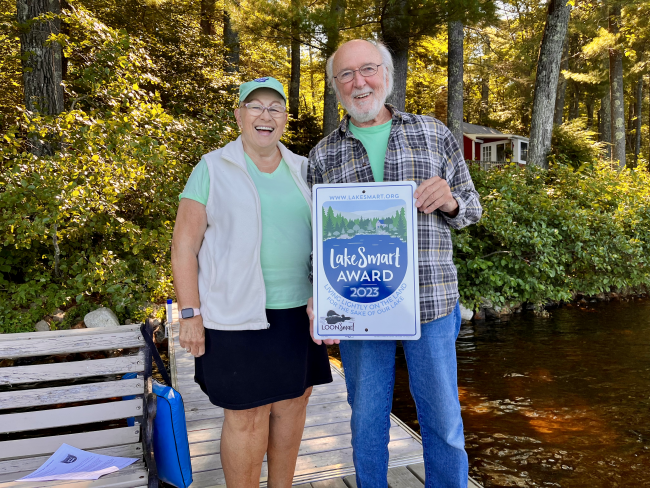LakeSmart is a state-wide outreach program through Maine Lakes that educates lakefront homeowners to manage their land to protect water quality. The program is free, non-regulatory, and voluntary. Participating homeowners receive individualized suggestions for keeping pollutants from stormwater out of lake waters.
LakeSmart is a program that educates landowners about best practices to protect the lakes they live on! The goal is to reduce or eliminate erosion and stormwater runoff because it carries pollutants, including phosphorus, a primary driver of algae growth. Properties that are particularly lake-friendly receive the LakeSmart Award, with accompanying signs for display.
LakeSmart is a program of Maine Lakes run in the Lake Region by the Lakes Environmental Association. If you live in LEA’s service area, contact emlyn@mainelakes.org to get involved in LakeSmart. If you live outside of our service area, contact info@lakes.me or visit lakes.me/lakesmart.
LakeSmart Homeowner Tips


LakeSmart properties are more natural than suburban — preventing erosion, providing wildlife habitat, food for pollinators, cooling shade, privacy screening, and so much more. They are functional properties, too — with docks, decks, recreation areas and winding paths.
Interested owners can request a free property evaluation. The evaluation involves a volunteer walking your property with you, looking at different criteria that affect lake health. Some questions LakeSmart volunteers are looking to answer are:
*a vegetated buffer is the trees, shrubs, and groundcover plants between your house and the lake that catch sediment and other pollution.
The evaluation report provides recommendations intended to make your property more lake-friendly by eliminating and preventing erosion or other pollution. It’s common that suggestions are made on its first evaluation! Common recommendations for improvement are:
If your property meets LakeSmart requirements, you get the LakeSmart award! Each award is accompanied by two distinctive signs intended for display at the shoreline and at the road. These signs encourage lake-friendly practices around your lake. There is no obligation to display the signs, although we hope you will.
Following every evaluation, you receive a written report with suggestions for increased lake-friendliness. There is no pressure or obligation to undertake the suggestions. If you choose to make changes, your property can be re-evaluated.

If you live in LEA’s service area (Bridgton, Denmark, Harrison, Naples, Sweden, and Waterford) contact emlyn@mainelakes.org. If you are outside of this area, contact info@lakes.me.
Soil naturally contains phosphorus, which feeds algae blooms on lakes. If stormwater carries soil into the lake, it can turn green and swampy (which is gross and unhealthy!).
Yes. The lawn does not provide lake protection, but a robust vegetated buffer between it and the lake can protect the lake. A lawn with a robust buffer protecting the lake can be LakeSmart.
Lawns often require fertilizer and pesticides which pollute lakes. Lawns offer little habitat to wildlife and pollinators. Lawns do very little stormwater infiltration and can cause runoff problems.
Nope! Free to all. The program is supported by a network of volunteers and donations to Lakes Environmental Association and Maine Lakes.
It is not just in lawn fertilizer. The number one pollutant of lakes is eroded soil carried in stormwater runoff from yards and roads. Phosphorus attached to the soil particles feeds algae in lakes. Algae blooms ruin the lake’s usefulness and lakeshore property values. Phosphorus is naturally-occurring in soil and plants, but human development has introduced it in excess to lakes and ponds.
Have an evaluation and figure out how you can improve. This is an opportunity to improve your impact, not a judgement of your property.
The LakeSmart program is always in need of additional evaluators. You should consider becoming an evaluator. Training takes about 3 hours, followed by accompanying an experienced evaluator on-site visits until you gain confidence. Contact lauren@mainelakes.org for more information.
LEA is proud to announce the 2023 participants of the LakeSmart Program in its regional Hub area. LEA thanks each of these individuals and families for helping to ensure that the beautiful lakes and ponds of this region stay pristine for generations to come.
2023 Lake Smart Participants
(Names in Bold received the LakeSmart Award)
Ronald Anderson (Kezar Lake)
James and Rachel Ash (Hancock Pond)
Robert Bast and Carolyn Kercsmar (Kezar Lake)
Robert Bickford (Moose Pond)
Mary Louis Blanchard (Kezar Lake)
Margaret, Harold, and Janet Buckingham (Kezar Lake)
Katy Briber (Kezar. Lake)
Stephen Buckley (Kezar Lake)
Jason and Christine Chasse (Moose Pond)
Laurence and Kathryn Clark (Hancock Pond)
Carolyn Conti (Kezar Lake)
Deborah Davis (Kezar Lake)
Beth Eames (Kezar Lake)
Andy and Cathryn English (Hancock Pond)
Chip English (Little Sebago Lake)
Susan Franzetti (Little Sebago Lake)
John and Wendy Furey (Woods Pond)
Glen Gerrish (Sand Pond)
Jim Gilchrist and Maria DelBaccaro (Moose Pond)
Daniel Goldberg (Long Lake)
Jack and Gretchen Grassmann (Little Sebago Lake)
Suzanne Hays (Kezar Lake)
Susan Hebert (Kezar Lake)
Elizabeth Hutchinson (Woods Pond)
Ingrid Johnson (Kezar Lake)
Gitte and Rick Irving (Highland Lake)
Geoffrey and Judy Jones (Sand Pond)
Beverly Keniston (Little Sebago Lake)
Margot Kingston (Woods Pond)
Roy Lambert and Mary Maxwell (Woods Pond)
Victoria Larson (Little Sebago Lake)
Stacy Lamson (Moose Pond)
Peter LaPolice (Moose Pond)
Michael McLeod (Moose Pond)
Jeffrey Mendel (Long Lake)
Wendy Molin and Daniel Mills (Kezar Lake)
Mary and John Morganti (Hancock Pond)
Irish Meusel (Hancock Pond)
Joseph Nagy and Myung-Hee Hur (Hancock Pond)
Melissa and John Nairn (Hancock Pond)
Bill Paulmann and Sarah Clemons (Kezar Lake)
Ben and Tim Peierls (Sand Pond)
George and Karena Poonen (Sand Pond)
PJ and Pam Ricatto (Moose Pond)
Bruce and Sharon Riedell (Long Lake)
John Roberts (Kezar Lake)
Cheryl Robertson (Long Lake)
David and Jeannine Rogers (Hancock Pond)
Kevin and Lori Ronan (Little Sebago Lake)
Ron and Anna Seekins (Little Sebago Lake)
Rick and Chris Siegrist (Moose Pond)
Lyman Smith (Kezar Lake)
Nancy Lubin and John Sopko (Long Lake)
Heidi and Barry Star (Kezar Lake)
Jan and Steve Stilkey* (Little Sebago)
Susan Welchman (Heald Pond)
Alan and Julie Whitaker (Woods Pond)
Hio Ridge Shores Association (Moose Pond)
The Narrows Lot Owners’ Association (Moose Pond)
